
Damodar River is a river flowing across the Indian states of Jharkhand and West Bengal. Rich in mineral resources, the valley is home to large-scale mining and industrial activity. Earlier known as the Sorrow of Bengal because of its ravaging floods in the plains of West Bengal, the Damodar and its tributaries have been somewhat tamed with the construction of several dams. It is the most polluted river of India.

The Subarnarekha River flows through the Indian states of Jharkhand, West Bengal and Odisha.
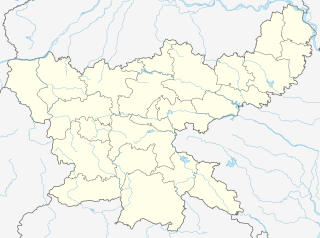
Maithon is a census town in Nirsa CD Block in Dhanbad Sadar subdivision of Dhanbad district in the Indian state of Jharkhand. It is situated on the banks of river Barakar
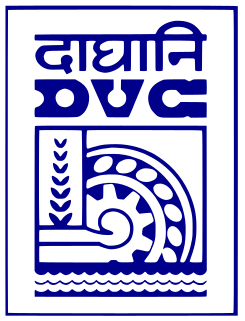
Damodar Valley Corporation (DVC) is an Indian governmental organization which operates in the Damodar River area of West Bengal and Jharkhand states of India. The corporation operates both thermal power stations and hydel power stations under the Ministry of Power, Govt of India. DVC is headquartered in the Kolkata city of West Bengal, India.
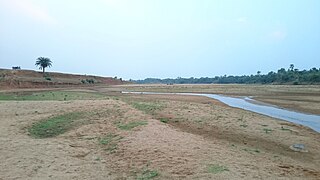
Mayurakshi River is a major river in Jharkhand and West Bengal, India, with a long history of devastating floods.

Mundeswari river is a small river in West Bengal which causes floods in Hooghly, Purba Medinipur and Howrah districts during the monsoons. Any discharge above 2,000 cubic metres per second (70,000 cu ft/s) downstream of Durgapur Barrage may cause flooding depending on the outfall condition of the Mundeswari at Harinkhola. It has been suggested that the banks of rivers such as Mundeswari should be protected with embankments to prevent floods.

Biharinath is the tallest hill of Bankura District, in the Indian state of West Bengal., and one of the dense forest areas of the district. It is a part of the Eastern Ghats. It is 451 metres (1,480 ft) high. It is situated about 60 kilometres (37 mi) north-west of Bankura town and 14 kilometres (9 mi) north-east of Saltora town.
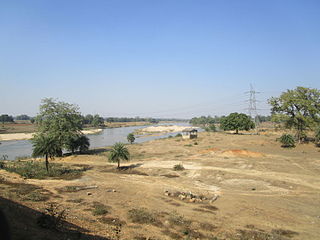
The Barakar River is the main tributary of the Damodar River in eastern India. Originating near Padma in Hazaribagh district of Jharkhand it flows for 225 kilometres (140 mi) across the northern part of the Chota Nagpur Plateau, mostly in a west to east direction, before joining the Damodar near Dishergarh in Asansol, Bardhaman district of West Bengal. It has a catchment area of 6,159 square kilometres (2,378 sq mi). The main tributaries, Barsoti and Usri, flow in from the south and north respectively. Apart from the two main tributaries some fifteen medium or small streams join it.

The Maithon Dam is located at Maithon, 48 km from Dhanbad, in the state of Jharkhand India. It is 15,712 ft (4,789 m) long and 165 ft (50 m) high.

Panchet Dam was the last of the four multi-purpose dams included in the first phase of the Damodar Valley Corporation (DVC). It was constructed across the Damodar River at Panchet in Dhanbad district in the Indian state of Jharkhand, and opened in 1959.

Randiha is a village in Galsi I CD block in Bardhaman Sadar North subdivision of Purba Bardhaman district in the Indian state of West Bengal.

Konar dam is the second of the four multi-purpose dams included in the first phase of the Damodar Valley Corporation. It was constructed across the Konar River, a tributary of the Damodar River in Hazaribagh district in the Indian state of Jharkhand and opened in 1955. The place has scenic beauty and has been developed as a recreational spot.
The Konar River is a tributary of Damodar River in Hazaribagh and Bokaro districts of the Indian state of Jharkhand.
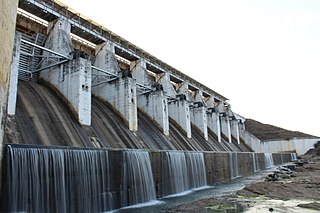
Tenughat Dam is an earthfill dam with composite masonry cum concrete spillway across the Damodar River at Tenughat in Petarwar block of Bokaro district in the Indian state of Jharkhand.

Tilaiya Dam was the first of the four multi-purpose dams included in the first phase of the Damodar Valley Corporation. It was constructed across the Barakar River, at Tilaiya in Koderma district in the Indian state of Jharkhand and opened in 1953.
Bokaro Thermal Power Station B is located at Bokaro district in Jharkhand, 44 km from the Bokaro Steel City and is about 55 km from Dhanbad city.. The nearest railway station is Bokaro Thermal. The power plant is one of the coal based power plants of DVC.

The Upper Wardha Dam is an earthfill straight gravity dam across the Wardha River, a tributary of the Godavari River, near Simbhora village in Morshi taluk in Amravati district in the Indian state of Maharashtra. The dam provides multipurpose benefits of irrigation, drinking water supply, flood control and hydropower generation.

The Polavaram Project is an under construction multi-purpose irrigation National project on the Godavari River in the West Godavari District and East Godavari District in Andhra Pradesh. The project has been accorded national project status by the Union Government of India and will be the last to be accorded the status. Its reservoir back water spreads up to the Dummugudem Anicut and approx 115 km on Sabari River side. It is located 40 km to the upstream of Sir Arthur Cotton Barrage in Rajamahendravaram City and 25 km from Rajahmundry Airport. Thus back water spreads into parts of Chhattisgarh and Odisha States. It gives major boost to tourism sector in Godavari Districts as the reservoir covers the famous Papikonda National Park, Polavaram Hydro electric project (HEP) and National waterway 4 are in under construction at left side of the river.

The Pazhassi Dam also called Kulur Barrage is a stone masonry diversion structure in Kannur district, Kerala, India. It is named after king Pazhassi Raja, a patriot who died a heroic death in the war. The dam is constructed across the west flowing Valapattanam River near VELIYAMBRA. It was commissioned by Prime Minister Morarji Desai in 1979. It mainly functions as an irrigation dam, serving a command area of 11,525 hectares in Thalassery and Thaliparambra taluks of the Kannur District. The water from this dam also meets the drinking water requirement of Kannur district. The dam site and the reservoir are famous for their scenic beauty.
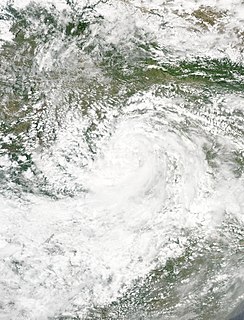
Following heavy rain in July and August 2017, the Indian state of West Bengal was affected by severe flooding. The floods were reported to have caused 50 deaths since 1 August and 8 deaths in the neighbouring state of Jharkhand.



















